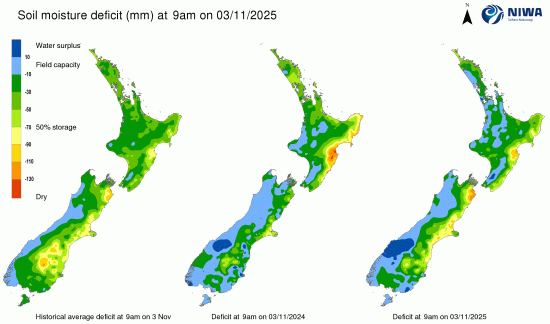
Here's our summary of key economic events over the long weekend that affect New Zealand, with more trade stutters, involving more US retribution by the US on Canada for perceived slights an insufficient subservience, to China failing to attract recovering foreign direct investment, to uncertainty around the upcoming US-China summit.
But first, this week we get the end of September quarterly data updates from the RBNZ, and we will get the household living cost index updates as well on Tuesday.
Internationally, there is the meeting coming up in Korea between Chinese President Xi and US President Trump. Delegations from the two superpowers have been meeting in advance in Malaysia to try to get something meaningful for their bosses to agree on. Both sides have a lot of 'face' to save. Early reports indicate significant agreements are possible.
Arguably equally important, the US Fed meets this week and will announce its decisions, also on Thursday. Currently markets have priced in a -25 bps cut to 4.0%. As their Federal government shutdown goes on and on, they will be having to use less formal data to inform their decisions. The recent Beige Book painted a lackluster picture.
Canada will also be reviewing their policy rate, and a -25 bps cut is expected there taking their policy rate to 2.25%. Japan is meeting too but no change is expected there. Ditto the ECB.
The week will also feature more October PMI reports from many countries. And there will be a rush on of earnings report releases. Australia will release its September CPI result and a 3% rate is anticipated.
Over the weekend, the US released its September CPI inflation data and it rose to 3.0%, up from 2.9% in August. This was slightly less than the expected 3.1% but it is still its highest level since June 2024. Energy costs, food and rents came in higher than that but petrol prices were lower.
One factor to watch is that the rate of increase in the past two months is closer to +4% on an annualised basis. The number reported today relies on the low increases they had in 2024 and February to May. When those months work their way out of the annual calculation, the higher pressure outside those periods will come into play.
Meanwhile, the University of Michigan consumer sentiment survey reported that Americans feel inflation is running at 4.6% and they downgraded their earlier confidence reading to now be -24% lower than year-ago levels.
The internationally benchmarked PMI report for the US for October reported a strong start to the fourth quarter, with expansions in both the services (55.2) and factory sectors (52.2).
The Canadian prime minister signaled that they are now re-orienting their trade away from with the US because of its unpredictability.
In India, their early PMI reports showed still high expansions in services (58.8) and in factories (58.4) but both levels were slightly lower than for September or any of the prior four months.
Japan’s inflation rate rose to 2.9% in September, up from a 10-month low of 2.7% in the previous month. Core inflation also came in at 2.9%, both basically as markets had expected.
Japan's services PMI eased slightly in October but is still expanding, even if not quite at the pace of September. But their contracting factory PMI got slightly worse in the month, according to the internationally benchmarked S&P Global PMI report out overnight.
Interestingly, China's President Xi did not send a congratulatory message to new Prime Minister Takaichi when she was elected, an unusual and pointed signal.
In China, the stutter they had in foreign direct investment in the April to June period seems to be over. In September, they attracted +¥68 bln in FDI, more than the +¥61 bln in the same month of 2024. But that earlier stutter still means they are running more than -10% lower than last year, and 2024 was the weakest year they had for foreign direct investment in more than a decade. It may be improving slightly, but they are still in a serious shadow.
In the EU, their early October PMI reported new order growth hitting a 2½ year high, and their services sector expanding at a good rate (52.8), and their factory sector no longer contracting (50.0).
In Russia, they cut their policy interest rate by -25 bps, the fourth consecutive rate cut and taking it to 16.5%, and contrasting with market expectations of a hold. The recent American sanctions probably caused them to act.
Australia's October services PMI rose to a faster expansion in October. But their factory PMI retreated from a small expansion to a small contraction.
We should also probably note that the price of aluminium (or aluminum if you prefer) is rising fast again, back up to levels first reached in the pandemic spike. Causing this current surge is the price the Americans are prepared to pay because of their self-imposed tariffs, as producers avoid that market. Those American buyers are being hit twice.
Also worth noting is a sudden rise in the price of sulfur (or sulphur if you prefer). Causing this spike is a fall in supply from some key oil producers (sulfur is a bi-product), when demand is rising for fertilisers.
The UST 10yr yield is now at 4.01%, up +1 bp from Saturday at this time and unchanged from this time last week. The key 2-10 yield curve is still at +51 bps. Their 1-5 curve is now at +1 bp. And their 3 mth-10yr curve is -2 bps inverted. The China 10 year bond rate is up +1 bp at 1.79%. The Australian 10 year bond yield starts today at 4.14%, down -2 bps from Saturday and a week ago. The NZ Government 10 year bond rate starts today at just on 4.02%, also unchanged from Saturday, up +3 bps from a week ago.
The price of gold will start today little-changed from Saturday at US$4111/oz, up +US$3, but down -US$110 for the week.
American oil prices are -holding from Saturday at just on US$61.50/bbl, with the international Brent price still just on US$66/bbl. Both at +US$4 higher than week-ago levels.
The Kiwi dollar is still at just on 57.5 USc, and again little-changed from Saturday, up +20 bps for the week. Against the Aussie we are also holding at 88.3 AUc. Against the euro we are still at 49.4 euro cents. That all means our TWI-5 starts today at just under 62.1 and essentially unchanged but up +30 bps for the week.
The bitcoin price starts today at US$113.581 and up +2.7% from this time Saturday. Volatility over the past 24 hours has been modest at just on +/- 1.2%.
Daily exchange rates
Select chart tabs
The easiest place to stay up with event risk is by following our Economic Calendar here ».
4 Comments
Funny how the US government shutdown was once an unprecedented event. Now it seems to happen annually.
The mechanics for government of the people, by the people for the people have been overwhelmed by the machinations of politics. You could add, in keeping with the age of that quote - gone with the wind.
It's only going to get worse as their debt spirals out of control in relation to their productivity. Keep an eye on their debt/gdp. The higher that ratio goes (above 100% as it is) the worse the political instability will become as each side blames the other. Like a squabbling husband and wife, each living beyond their means, arguing over the credit card bill, and unable to realise that they need to balance their spending in order to avoid catastrophe. 'Its your fault for buying too many dresses' says the husband to the wife....'No its your fault for buying too many toys' says the wife to the husband. Democrat vs Republican arguments are exactly the same but the miss the key fact that unless the collectively get their shit together, it ends really badly.
I personally believe we're witnessing the end of the US as the dominant world power and these issues with govenment debt and the related political instability that goes with it are sure signs of a slow motion train wreck (closing decades of an empire - it could rescue itself of course but it would require cooperation and sacrifice - but there are no signs of such occuring at present - it appears the fighting and division between both sides is getting worse - just as it does in partners heading towards divorce or financial bankruptcy).
One wonders how the MAGAts are going to react when inflation spikes again because of tariffs, their healthcare premiums sky rocket, the lose SNAP benefits (and a host of others if Trump goes through with his plans to "punish dems" for shutting down the government to stop these things from happening). Oh I know exactly how it will go actually. Blame the democrats, blame Obama, blame the immigrants, blame anyone but the guy actually doing these things.


We welcome your comments below. If you are not already registered, please register to comment.
Remember we welcome robust, respectful and insightful debate. We don't welcome abusive or defamatory comments and will de-register those repeatedly making such comments. Our current comment policy is here.